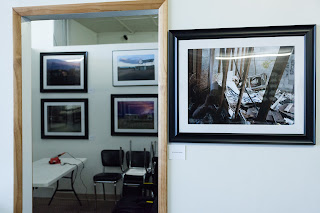The town of Bosler, Wyoming was one of the many victims of
the modernization of America. Similar to other small towns that dotted the
landscape of the American West in the early to mid-twentieth century, this town
all but disappeared when the Interstate Highway system was completed and
by-passed the town twenty miles to the south. The town’s Post Office was
incorporated on May 3rd, 1900, and closed sometime in the mid-1980’s.
Bosler was originally a rail stop for the ranch concerns of
the Bosler family, who owned two ranches and other businesses in the area.
According to the 1940 U.S. Census, the town boasted a total of 264 souls; had a
garage, two motels, and a handful of other business concerns.
The town’s population has dwindled to its current residency
of less than ten. Only one commercial business remains: Doc’s Western Village.
It’s primarily a furniture outlet, and most people driving through would assume
it to be closed, given the signage hasn’t been updated in over twenty years.
This town is an example of what has been left behind in the
name of progress. This is a place where people lived, enjoyed a livelihood and
raised families. A place where people knew each other; attended Saturday night
dances, and Sunday morning church services. Today, it’s nothing more than a disappearing
dot on a map. The one remaining store was converted from one of the motels, the
other motel had no indoor plumbing. It had four cabins along with a his and her
outhouse. It stands as a sculpture of buildings weathered and beaten by time;
how much longer they will remain standing is anyone’s guess.
I’ve often travelled through towns like this, and
questioned; who thought this place would be good for some defined or undefined
purpose? What was the attraction? Why did this place begin to fade? What caused
its demise? Economic conditions? Environmental concerns? Were the local
resources exhausted? Where did the people who occupied this space go? Did they
die? Move on? When did they leave? Have they ever come back to see what they
left behind?
I seek answers to these questions, and I only wish to
capture the remains of the structures before they disappear. I also yearn to
find beauty in the desertion, desolation, and dilapidation of what has been
left behind in the isolated and forgotten places such as this.
(Please click on the images for a larger view)
 |
| This motel dates back to the 1920's. |
 |
| Looking out from my motel room... |
 |
| The women's room of the outhouse as seen from cabin # 1. |
 |
| The entrance to the Bosler Consolidated School. |
 |
| The last class to graduate from the Bosler Consolidated School was in 1983. |
 |
| The main floor of the school. |
 |
| The gymnasium did double duty; it also served as an auditorium. |
 |
| The stage has collapsed under the weight of an old American V-8 engine. |
 |
| The occupancy sign remains by the entrance to the gym. |
 |
| One of the classrooms has the remnants of the people who lived here in the late 1980's. |
 |
| How many people learned to sew with this machine? |
 |
| Although no one has called the school home in over 20 years, this set of handyman books is in pristine condition. |
 |
| The note between the sink basins reads:"This water is unsafe for drinking." |
 |
| One of the classrooms is home to a pair of motorcycles. |
 |
| A lone homestead begins another day along the old Lincoln Highway. |
 |
| Doc's Western Village is still open for business. |




































